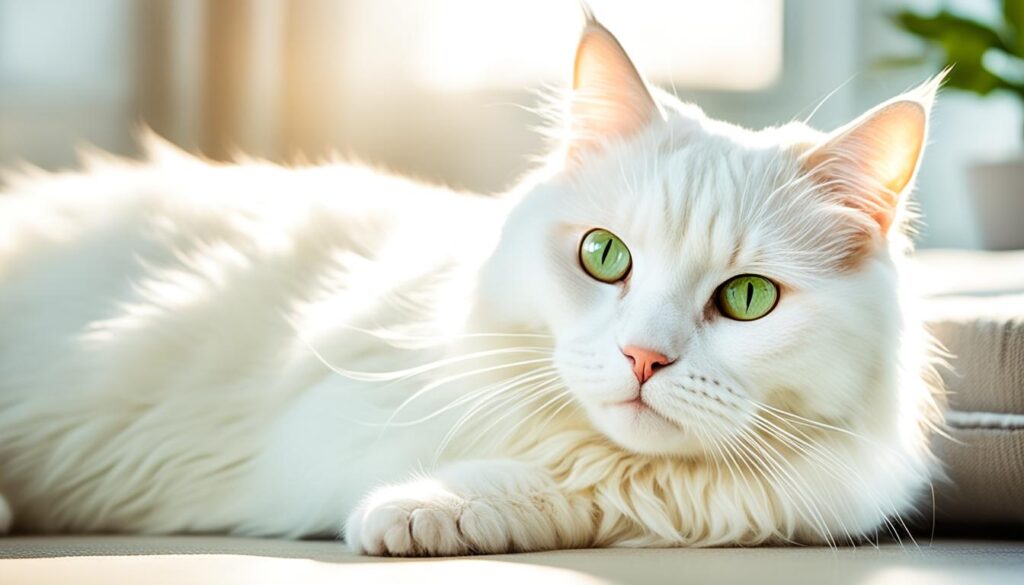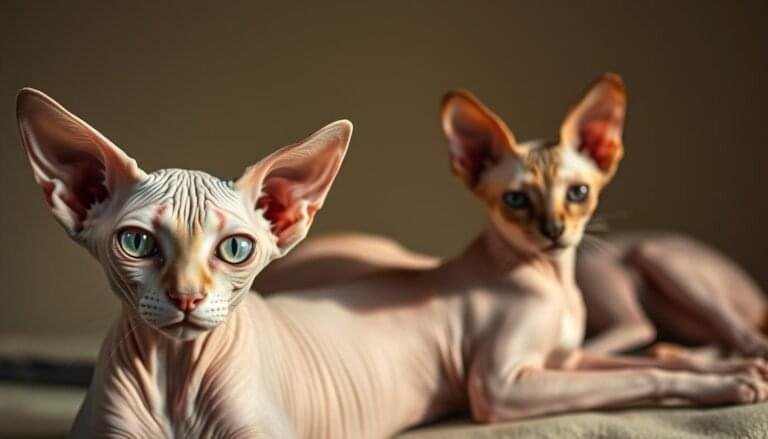Cats for Allergy Sufferers: Did you know that approximately 10% of the population in the United States is allergic to cats? If you’re one of the millions of people who suffer from cat allergies, you may think that owning a cat is simply out of the question. However, there is good news for allergy sufferers – certain cat breeds are more hypoallergenic and can be a better fit for people with allergies.
Contrary to popular belief, it’s not the cat’s fur that causes allergies, but rather the proteins found in their body. Dander, the tiny bits of dried, dead skin that cats shed, is the biggest trigger for allergies. However, different cat breeds shed dander in varying levels and some naturally produce lower levels of allergenic proteins. While no cat can be considered 100% hypoallergenic, there are breeds that are more allergy-friendly than others.
Cats for Allergy Sufferers – Key Takeaways:
- Approximately 10% of the U.S. population is allergic to cats.
- Allergies to cats are caused by proteins found in their body, not their fur.
- Dander, the bits of dried, dead skin cats shed, is the main trigger for allergies.
- Some cat breeds naturally produce lower levels of allergenic proteins.
- No cat can be considered completely hypoallergenic, but some breeds are more allergy-friendly than others.
What Causes Allergies to Cats?
Cat allergies are caused by specific proteins produced by the cat’s body, such as Fel d 1 and Fel d 4. These proteins can be found not only in the cat’s fur, but also in their blood, sweat, urine, saliva, and dander. Dander, which consists of tiny bits of dried, dead skin, is the main trigger for allergies. It is important to note that it’s not the cat’s fur itself that causes allergies, but rather the proteins that can be present in various parts of the cat’s body.
The Role of Fel d 1 and Fel d 4
Fel d 1 is a protein that is primarily found in a cat’s saliva and sebaceous glands. During grooming, cats spread this protein onto their fur when they lick themselves, which can then become airborne, leading to allergic reactions in sensitive individuals.
Fel d 4, on the other hand, is a protein found in a cat’s urine. When a cat uses a litter box, traces of this protein can stick to their paws and subsequently be transferred onto their fur, increasing the likelihood of allergic reactions.
These allergenic proteins can also become airborne when cats shed their dander, further adding to the exposure and potential for allergic reactions.
Allergen Distribution
It is important to note that these allergenic proteins are not only present on a cat’s fur but can also be found on surfaces where cats have been, such as furniture, carpets, and bedding. Additionally, they can remain in the environment for extended periods, continuing to trigger allergies even in the absence of direct contact with a cat.
Individual Sensitivities
While Fel d 1 and Fel d 4 are widely recognized as common cat allergens, it’s essential to remember that individual sensitivities to these proteins can vary. Some individuals may be more sensitive to one protein over the other, or both proteins may contribute to their allergies. Understanding these variations can inform decisions regarding cat breeds and allergen management strategies.
Top 10 Hypoallergenic Cat Breeds
While no cat can be considered completely hypoallergenic, there are certain breeds that produce lower levels of allergenic proteins. These breeds are often referred to as hypoallergenic cat breeds and are more suitable for individuals with allergies. If you’re looking for a low-allergy cat or a non-shedding cat breed, here are the top 10 hypoallergenic cat breeds to consider:
| Breed | Description |
|---|---|
| Siberian | The Siberian cat is known for producing lower levels of the allergenic protein Fel D1 while having a thick, dense coat that may reduce dander. |
| Balinese | The Balinese cat is a long-haired breed with low levels of allergenic proteins and minimal shedding, making it a good choice for allergy sufferers. |
| Bengal | The Bengal cat has a short, low-maintenance coat with reduced levels of allergenic proteins, making it a popular choice for people with allergies. |
| Russian Blue | The Russian Blue cat is known for its short, dense coat that produces low levels of allergenic proteins, making it a hypoallergenic option. |
| Sphynx | The Sphynx cat is a hairless breed, which means it doesn’t shed as much dander as other cats and may be a good choice for individuals with allergies. |
| Burmese | The Burmese cat has a short, easy-to-maintain coat that produces fewer allergens, making it a hypoallergenic option for allergy sufferers. |
| Javanese | The Javanese cat is another breed that produces lower levels of allergenic proteins and may cause fewer allergy symptoms in sensitive individuals. |
| Oriental Shorthair | The Oriental Shorthair cat has a short coat that sheds less and produces fewer allergens, making it a suitable choice for people with allergies. |
| Turkish Angora | The Turkish Angora cat has a single, silky coat that requires minimal grooming and produces fewer allergens, making it a hypoallergenic option. |
| Siamese | The Siamese cat is known for its short coat and lower levels of allergenic proteins, making it a popular choice for allergy sufferers. |
These hypoallergenic cat breeds offer a range of choices for individuals with allergies who still want to enjoy the companionship of a feline friend. However, it’s important to spend time with the specific breed to determine how your allergies react before making a decision. Remember, individual reactions to cat allergens can vary, and what works for one person may not work for another.
Lowering the Chances of Allergic Reaction
If you have allergies but still want to have a cat, there are several steps you can take to lower the chances of an allergic reaction. By implementing these measures, you can enjoy the company of a feline companion without compromising your health.
Frequent Cleaning
Keeping your home clean is essential for minimizing allergens. Regularly vacuum and dust your living areas, paying special attention to carpets, upholstery, and curtains where cat fur and dander can accumulate. This will help reduce the presence of allergens in your environment.
Using Protective Gear
When performing cleaning tasks that may agitate allergens, such as vacuuming or dusting, consider wearing a face mask to prevent inhaling them. This can provide an additional layer of protection against allergic reactions.
Air Purification
Investing in an air purifier can significantly improve the air quality in your home by removing allergens and other fine particles. Look for a purifier with a high-efficiency particulate air (HEPA) filter, as it can capture even the smallest allergen particles.
Maintaining Cat Hygiene
Regularly cleaning your cat’s litter box is essential for minimizing allergens in your home. Clean the litter box daily to reduce the spread of allergenic particles. Additionally, make it a habit to brush your cat regularly to remove loose fur and dander, further reducing the potential for allergic reactions.
Medical Consultation
If you’re still experiencing significant allergic reactions despite taking preventive measures, it’s crucial to consult with your doctor. They may recommend antihistamines or other medications that can help alleviate your symptoms and provide cat allergy relief.
While these measures can help mitigate the risk of allergic reactions, it’s important to keep in mind that no cat is completely allergen-free. Individual reactions to allergens may vary, and it’s essential to monitor your symptoms and consult with a healthcare professional for personalized advice.
What Is a Hypoallergenic Cat?

While there is no completely hypoallergenic cat, some breeds are considered hypoallergenic because they produce lower levels of the proteins that trigger allergies in people. These proteins, such as Fel D1, are found in a cat’s fur, saliva, and urine. Hypoallergenic cats produce fewer allergens, making them a better fit for people with allergies. However, it’s important to note that individual reactions to cat allergens can vary, so spending time with the breed to determine how your allergies react is crucial before bringing a hypoallergenic cat into your home.
| Breed | Allergenic Protein Levels |
|---|---|
| Siberian | Low |
| Balinese | Low |
| Bengal | Low |
| Russian Blue | Low |
| Sphynx | Low |
Cats That Are Hypoallergenic
While no cat is completely hypoallergenic, there are certain breeds that produce lower levels of allergens, making them more suitable for people with allergies. Some popular hypoallergenic cat breeds include the Siberian, Siamese, Bengal, Russian Blue, and Sphynx. These breeds have been found to produce fewer allergens, particularly the Fel D1 protein, which is a common trigger for allergies.
Individual allergies can vary, so it’s recommended to spend time with the specific breed before bringing them into your home to ensure compatibility.
| Cat Breed | Fel D1 Protein Level |
|---|---|
| Siberian | Low |
| Siamese | Low |
| Bengal | Low |
| Russian Blue | Low |
| Sphynx | Very low |
While these breeds have been shown to produce lower levels of allergens, it’s important to monitor your individual allergic reactions when interacting with these cats. Spending time with the specific breed and potentially consulting with an allergist can help determine their compatibility with your allergies.
Tips for Adopting a Hypoallergenic Cat

If you’re considering adopting a hypoallergenic cat, there are a few tips to keep in mind. First, do your research and spend time with the cat before bringing them home to see how your allergies react. Consulting with an allergy specialist can also be helpful in determining the severity of your symptoms and getting medication recommendations.
It’s important to keep your home clean to minimize exposure to allergens. Regularly wash bedding and toys to remove allergens that may have accumulated. Consider using products specifically designed to reduce allergens in your home environment.
Additionally, talking to your veterinarian about hypoallergenic cat food that can help reduce allergens in their hair, dandruff, and saliva may also be beneficial in minimizing your exposure to allergens.
Allergy Symptoms Checklist
- Sneezing
- Runny or stuffy nose
- Congestion
- Itchy or watery eyes
- Coughing
- Wheezing
Allergen Reduction Products
| Product | Description |
|---|---|
| Allergen-blocking bedding | Designed to prevent allergens from penetrating your bedding |
| Air purifier | Filters the air and removes allergens |
| Hypoallergenic cleaning products | Formulated to minimize allergen presence |
Other Cats That May Reduce Allergy Symptoms
In addition to the popular hypoallergenic cat breeds mentioned earlier, there are other cat breeds that may also reduce allergy symptoms. These breeds include the Burmese, Javanese, Oriental Shorthair, and Turkish Angora. While they may not be as widely recognized as hypoallergenic breeds, they have been found to produce fewer allergens and may be a good fit for allergy sufferers. It’s important to note that individual reactions to cat allergens can vary, so spending time with the specific breed before bringing them into your home is recommended.
When it comes to finding a cat that won’t trigger allergy symptoms, exploring different breeds can open up new possibilities. The Burmese, with its short coat and reduced dander production, is known to be hypoallergenic-friendly. The Javanese, known for its silky coat and minimal shedding, is another option for allergy sufferers. The Oriental Shorthair, with its slender build and low allergenic protein levels, is a popular choice for people with allergies. Finally, the Turkish Angora, with its semi-long coat and low allergenic protein levels, is another breed to consider.
While these breeds may not be as well-known as the Siberian or Sphynx, they offer a viable alternative for individuals looking for cats with reduced allergenic properties. However, it’s important to remember that individual reactions may vary, and spending time with the specific breed is crucial before making a decision. By exploring different cat breeds and considering their allergenic properties, allergy sufferers can find a furry companion that brings joy without triggering uncomfortable symptoms.
Conclusion
While no cat can be considered completely hypoallergenic, there are cat breeds that produce lower levels of allergens, making them more suitable for people with allergies. These hypoallergenic breeds, such as the Siberian, Balinese, Bengal, Russian Blue, and Sphynx, among others, have been found to be less likely to trigger allergic reactions in individuals.
It’s important to note that individual reactions to cat allergens can vary, so it’s recommended to spend time with the specific breed before bringing them into your home. This allows you to assess how your allergies may react to the hypoallergenic cat breed you’re considering.
In addition to spending time with the breed, there are precautions you can take to further reduce the chances of experiencing an allergic reaction. Regular cleaning of your home, including vacuuming and dusting, can help control the levels of allergens in the environment. Regular grooming and bathing of your hypoallergenic cat can also minimize the presence of allergens on their fur. Consulting with allergy specialists and veterinarians can provide further guidance and recommendations tailored to your specific situation.
By taking these precautions and considering hypoallergenic cat breeds, allergy sufferers can find feline companionship without the worry of severe allergic reactions. If you’re interested in adding a hypoallergenic cat to your family, research reputable sources and cat breeders who have hypoallergenic cats for sale to ensure the cat you choose is indeed from the desired hypoallergenic breed.
FAQ
What are hypoallergenic cat breeds?
What causes allergies to cats?
Which cat breeds are considered hypoallergenic?
How can I lower the chances of an allergic reaction to cats?
What is a hypoallergenic cat?
Are there any other hypoallergenic cat breeds?
What tips should I consider when adopting a hypoallergenic cat?
Are there other cat breeds that may reduce allergy symptoms?
Are there completely hypoallergenic cats available for sale?
References
| International Cat Association (TICA) | https://www.tica.org/ |
| The Cat Fanciers’ Association (CFA) | https://cfa.org/ |
| World Cat Federation (WCF) | https://www.wcf-online.de/ |
| Fédération Internationale Féline (FIFe) | https://www.fifeweb.org/ |








[…] a hairless breed, Sphynx cats are often considered a hypoallergenic cat choice for individuals with cat allergies. While there is no such thing as a completely hypoallergenic cat, Sphynx cats are less likely to […]
[…] Bengal cats are not considered hypoallergenic. They do produce some allergens, like other cats, but some people with allergies may be able to […]
[…] for people with allergies due to their hypoallergenic […]
[…] there are no completely hypoallergenic cat breeds, some breeds like the Sphynx and Devon Rex produce less allergens and may be a good option […]
[…] Did you know that more than 46 million homes in the U.S. have a cat? Cats are beloved companions, but for those with allergies, owning a cat can be a challenge. However, there is hope for cat lovers who suffer from allergies – hypoallergenic cats. These special breeds of cats produce lower levels of the proteins that trigger allergies, making them a more allergy-friendly option. While there is no completely hypoallergenic cat, certain breeds might be a better fit for allergy sufferers. […]